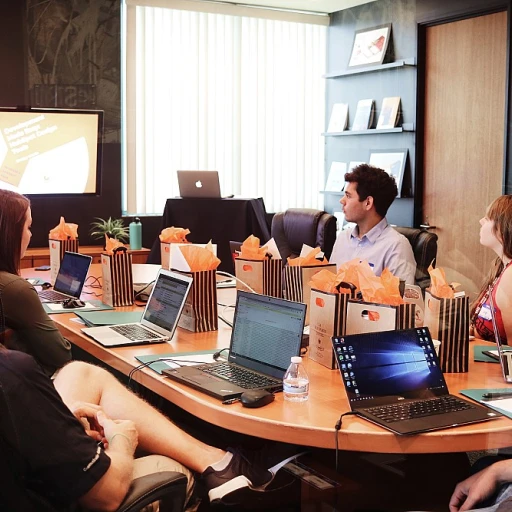
Understanding the Need for Reskilling
Why Reskilling is Essential in Today's Workplace
In the rapidly evolving business landscape, the concept of reskilling has become more critical than ever. With technology continuously reshaping how companies operate, employees often find themselves in need of acquiring new skills to stay relevant and meet future challenges. This necessity extends beyond traditional career paths, directly impacting employee development, professional growth, and even leadership opportunities within an organization.
Companies that prioritize reskilling help employees realign with their evolving career aspirations and career goals. As businesses adapt to market changes, the demand for adaptable team members with updated expertise grows. By investing in reskilling opportunities, organizations empower employees to enhance their skills, promoting not only individual growth but also overall company success.
For many employees, the prospect of reskilling offers a way to diversify their career path and explore new career development avenues. This emphasis on continuous learning ensures that professionals remain competitive, broadening their professional network and deepening their industry knowledge.
Acknowledging the aspirations examples of employees is as crucial as the reskilling itself. It allows for personalized professional development plans that align individual goals with organizational objectives, contributing significantly to overall team morale and motivation. When employees feel supported in their career journeys, they are more likely to display increased commitment and job satisfaction.
To effectively address the needs of the modern workforce, empowering employees through a structured professional development committee can provide the framework necessary for career growth and development. By addressing these questions career, organizations can take decisive steps toward ensuring they remain competitive in an ever-changing environment.
Identifying Personal and Professional Aspirations
Navigating Personal and Career Ambitions
Exploring your personal and professional aspirations is a crucial step in the reskilling journey. It involves recognizing what you want to achieve in your career and reflecting on your goals and ambitions. This self-analysis helps employees feel aligned with their work, offering them a clear career path and empowering them to strive for professional growth.
Employees often begin by asking themselves substantial questions about their career aspirations and goals. This introspection can reveal what drives their sense of fulfillment and ambition in the professional world. Are you aiming for leadership roles? Maybe you wish to excel in your current field, or perhaps you dream of transitioning into a completely different career. Such clarity will guide you in tailoring your reskilling endeavors to suit your life’s goals.
Identifying Goals for Professional Growth
Once you have an understanding of your aspirations, it is essential to identify specific career goals. These can range from short-term objectives, such as acquiring new skills, to long-term targets like a significant career transformation. When employees establish clear career goals, they create benchmarks for their progress, which can catalyze their development.
- What are the critical skills you need to reach your goals and align with company aspirations?
- How do your goals align with the opportunities available within your current job or within your industry?
The answers to such effective strategies inform your roadmap, ensuring you focus your learning efforts where they will be most impactful, benefiting both personal aspirations and the business as a whole.
In this process, fostering conversations with team members and leaders can offer insight and guidance on development needs and existing opportunities within the organization. Establishing a support network can provide invaluable feedback as you advance through your career journey.
Creating a Reskilling Roadmap
Crafting a Roadmap for Skills Development
When it comes to building a career path that aligns with both personal and professional growth, creating a structured reskilling roadmap is crucial. This roadmap acts as a guide that helps employees identify their current skills and determine the competencies they need to develop to meet their career aspirations and goals. To start, individuals should conduct a self-assessment to evaluate their existing skills and identify areas where development is necessary. This step involves reflecting on one's career journey, including any setbacks or successes, to better understand what areas require improvement. By being aware of their skills gap, employees can set realistic and attainable career goals that further their aspirations and enhance their contribution to the company. Next, it's important to define career goals that are aligned with long-term aspirations. While some goals may focus on immediate job responsibilities, others may relate to broader career development, such as obtaining leadership roles or participating in team management. For instance, an employee might aim to develop leadership skills to enhance opportunities for professional growth and to empower themselves in their current roles. Once goals and aspirations have been identified, individuals can then focus on identifying courses or training programs that will help bridge the skills gap. This may involve enrolling in online courses, attending workshops, or participating in company-sponsored training sessions. It's beneficial for employees to explore various opportunities for learning, tailoring their choices to suit their unique career aspirations and the specific needs of the business. In the modern workplace, leveraging technology tools is an essential aspect of reskilling. Learning management systems, online platforms, and apps can facilitate expansive learning and provide resources that align with one's career goals and professional development plans. Exploring the distinction between [[norm skills and meta skills]](https://www.reskilling-trends.com/blog/understanding-the-difference-between-norm-skills-and-meta-skills-in-reskilling) can help employees make informed decisions on which areas to prioritize. A well-defined reskilling roadmap not only helps employees feel more engaged and motivated but also supports the company's aim to nurture top talent and retain its valuable team members. By investing time in crafting such a roadmap, employees can embark on a rewarding career journey, where opportunities for growth and advancement are continuous and fulfilling.Leveraging Technology for Effective Reskilling
Harnessing the Power of Technology for Skill Enrichment
In today's rapidly evolving work environment, technology stands as a formidable tool in enabling effective reskilling. For employees eager to advance their career aspirations, leveraging digital platforms can bridge the gap between their current skills and their professional growth goals. To begin with, online learning platforms are revolutionizing how employees view career development. These resources offer a plethora of courses and training materials that employees can access at their own pace. This flexibility is particularly beneficial for balancing professional commitments with learning new skills, encouraging long-term growth. Moreover, many companies are now utilizing interactive tools such as virtual reality (VR) and augmented reality (AR) in their reskilling programs. These innovative technologies provide immersive learning experiences that closely mimic real-world scenarios, fostering both job-related skills and leadership capabilities. For businesses aiming to empower employees and maintain top talent, incorporating AI-driven assessments can be a game changer. These tools can analyze and identify gaps in an employee's skill set, offering personalized learning paths. As a result, team members gain an understanding of their strengths and areas for improvement, ultimately driving both personal and professional development. It is crucial for businesses to foster a supportive culture that encourages employees to engage with technology-driven reskilling initiatives. By doing so, companies not only enhance employees' career growth but also contribute to overall team development. As employees feel more competent and versatile, their contributions to the company increase, creating a cycle of continuous improvement. While technology offers immense opportunities, it is important to address the challenges it may pose. Barriers such as digital literacy must be carefully managed to ensure all employees can participate effectively in tech-based learning. Clearing these obstacles ensures that everyone, regardless of their initial skill level, can benefit from digital reskilling initiatives. In conclusion, integrating technology into reskilling not only equips employees with the necessary skills to meet their career goals but also strengthens the company's workforce as a whole. Embracing these digital resources and overcoming challenges together can set the foundation for a robust and future-proof business environment.Overcoming Challenges in Reskilling
Addressing Common Reskilling Obstacles
Reskilling is a crucial step in aligning career aspirations with the ever-evolving demands of the workplace. However, it is not without its challenges. Understanding these hurdles can help employees and companies develop effective strategies to overcome them, ensuring that reskilling efforts lead to meaningful career development.
Balancing Work and Learning
One of the primary challenges employees face is balancing their current job responsibilities with new learning opportunities. Companies can support their team members by offering flexible learning schedules or integrating learning into the workday. This approach helps employees feel less overwhelmed and more motivated to pursue professional growth.
Financial Constraints
Financial limitations can be a significant barrier to reskilling. Companies that invest in their employees by providing financial assistance or covering the costs of courses and certifications empower employees to pursue their career goals without the burden of financial stress. This investment in top talent not only aids in career growth but also enhances the company’s competitive edge.
Resistance to Change
Employees may resist reskilling due to fear of change or uncertainty about the future. Leadership plays a crucial role in addressing these concerns by fostering a culture of continuous learning and development. Encouraging open communication and providing clear examples of how reskilling can lead to new career opportunities can help employees overcome their apprehensions.
Lack of Clear Goals
Without clear career aspirations or goals, reskilling efforts can feel aimless. Companies should work with employees to identify their professional aspirations and create personalized career paths. This guidance helps employees align their learning with their long-term career journey, making the process more purposeful and effective.
Ensuring Skill Relevance
Another challenge is ensuring that the skills being developed are relevant to the current and future needs of the business. Regularly assessing the company’s strategic goals and aligning reskilling programs with these objectives ensures that employee development contributes to both individual and organizational growth.
By recognizing and addressing these challenges, companies can create a supportive environment that facilitates effective reskilling. This not only helps employees achieve their career aspirations but also strengthens the organization as a whole.
Measuring the Impact of Reskilling on Workplace Aspirations
Evaluating Impact on Career Development
When it comes to understanding the effectiveness of reskilling efforts, measuring the impact on career development is vital. It requires focusing not just on the acquisition of new skills but also on how these new abilities translate into tangible outcomes within the workplace. Here are some key elements to consider:- Professional Growth and Opportunities: Observe whether employees experience an increase in professional growth and career opportunities. This can include promotions, new roles, or expanded responsibilities that align with their career aspirations and goals.
- Employee Satisfaction: Monitor how employees feel about their career path post-reskilling. Are they more engaged and satisfied with their work? High levels of employee satisfaction often correlate with successful reskilling programs that empower employees to reach their full potential.
- Skill Utilization: Assess how effectively new skills are being utilized in the workplace. This involves looking at how team members apply their learning to drive business growth and support the company’s objectives.
- Leadership and Team Dynamics: Evaluate the impact on leadership qualities and team dynamics. Reskilled individuals often contribute to better leadership within teams, enhancing overall team collaboration and performance.













